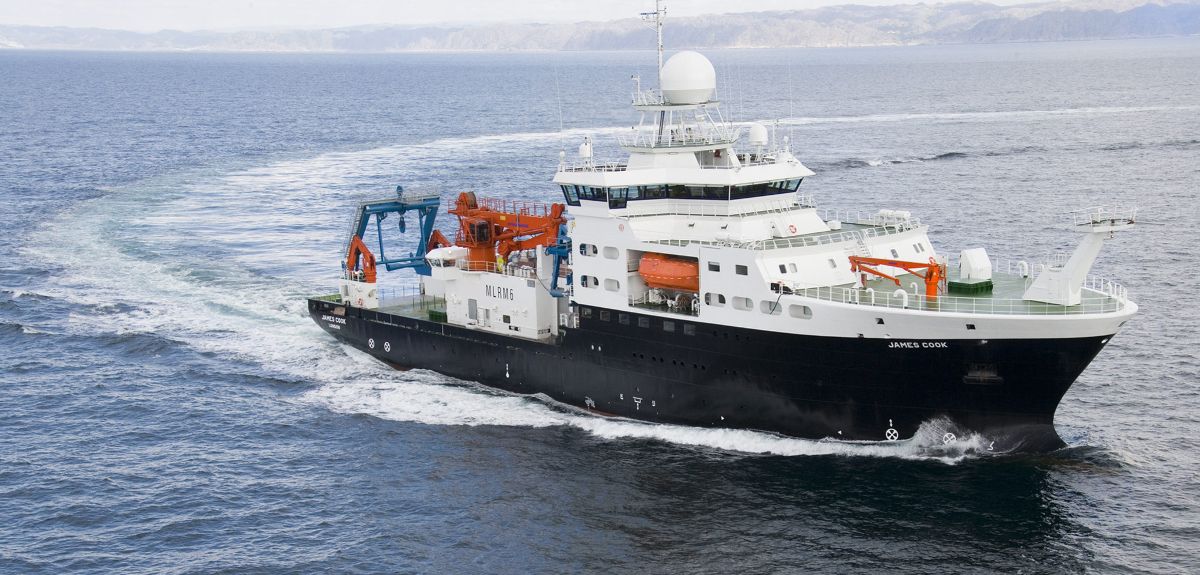
Image credit: National Oceanography Centre
All aboard
A team from Oxford University has teamed up with colleagues at Plymouth for a six week voyage of discovery around the North Atlantic on UK research ship RRS James Cook, as the Science Blog found out.
Until the fuss around #BoatyMcBoatface, the UK's fleet of Royal Research Ships (RRS) has been little known beyond the scientists who use them and the odd maritime enthusiast. But they are a vital part of understanding our oceans and much in demand.
Very little is known about how well connected deep-sea organisms are over depth and across local, regional and oceanic distances.
Dr Michelle Taylor, Ocean Research and Conservation Group, Department of Zoology
The opportunity to make a sea-going expedition is therefore rare, explains deep sea ecologist Dr Michelle Taylor, one of those leading the 16-strong team, which set sail on 14 May. Amidst final preparations, she notes that the last sea-going expedition her lab undertook was a NERC-funded expedition on the same vessel, the RRS James Cook, to the South West Indian Ocean in 2011.
This year's opportunity may, on the face of it, seem a little less exotic. The Northeast Atlantic is closer to home for starters. But look beneath the surface - literally in this case - and things get more interesting.
The expedition is part of the Deep Links project, as Dr Taylor explains: 'Very little is known about how well connected deep-sea organisms are over depth and across local, regional and oceanic distances. Species populations are connected to each other through both movement of adults – migration – and the movement of eggs, larvae, and juveniles – dispersal. If populations become isolated from one another so they are no longer connected, then through genetic mutation, drift and natural selection, they may become so different that they evolve into new biological species, a process called speciation.
'Understanding how populations become isolated is critical to understanding the process of speciation. In the marine environment, many species, such as corals, do not move as adults or move very slowly, sea urchins for example. This means that for different adult populations to remain connected they rely on dispersal of early life history stages. Most marine species have a larval stage that lives in the water column for a period of time, moving with the currents, before settling in a new area. It is larval dispersal that keeps distant populations connected. So understanding patterns of larval dispersal is important for understanding connectivity.'
The practical upshot of that ambition is that the James Cook will visit seamounts across the Northeast Atlantic so that the researchers can use a remotely operated vehicle to collect corals, sea urchins and sea cucumbers to try to find out what drives genetic variation across this area at different depths.
'Such information is important in defining the size of and specific areas that should be targeted for conservation or closed to destructive activities,' says Dr Taylor.
Even a few years ago that might have been a less pressing question but the move towards more and more use of the sea, especially for deep sea mining, means that we can no longer take for granted that these areas of the ocean will be undisturbed.
'Governments all over the world are setting up networks of Marine Protected Areas (MPAs) to protect against serious ecosystem disturbance. There are many questions to be answered when trying to set up an MPA network, but one important question is where to put them to make sure that the populations that live within them are not isolated from each other but are connected. This research will help answer this question in the deep sea, and so help us ensure the long-term health of the ocean.'
Life on board
The aim is to gather as much information as possible during the six weeks, so every member of the science crew will be on a 12 hour shift, a necessity when undersea surveys can be 18 hours long.
Depending on if you are on days of nights you will wake for breakfast or for the evening meal, which makes for an unusual array of breakfast choices.
Dr Michelle Taylor
Dr Taylor says: 'Depending on if you are on days of nights you will wake for breakfast or for the evening meal, which makes for an unusual array of breakfast choices in addition to the usual cereal options.
'Both shifts will have similar responsibilities. These include watching the live video feeds from the remotely operated vehicle, Isis, recording animal locations as well as selecting which organisms will be sampled and, at the end of the survey, brought back to the surface.
'We therefore also have scientists to sub-sample the organisms on the ship – work that is undertaken in a 4 degree cold room, the temperature of the deep-sea. They record images of the organisms and curate them. There is always a lot of computer based curation too for the images and data from each animal. Taxonomists on board will also be doing a lot of identifications.
'There is lots to do and no day is likely to be the same.'
Once back on dry land, the team will analyse their results and what they have gathered. Overall, Deep Links is a three year project.
You can follow the voyage on the Deep Links website or by using any of the links on the right.